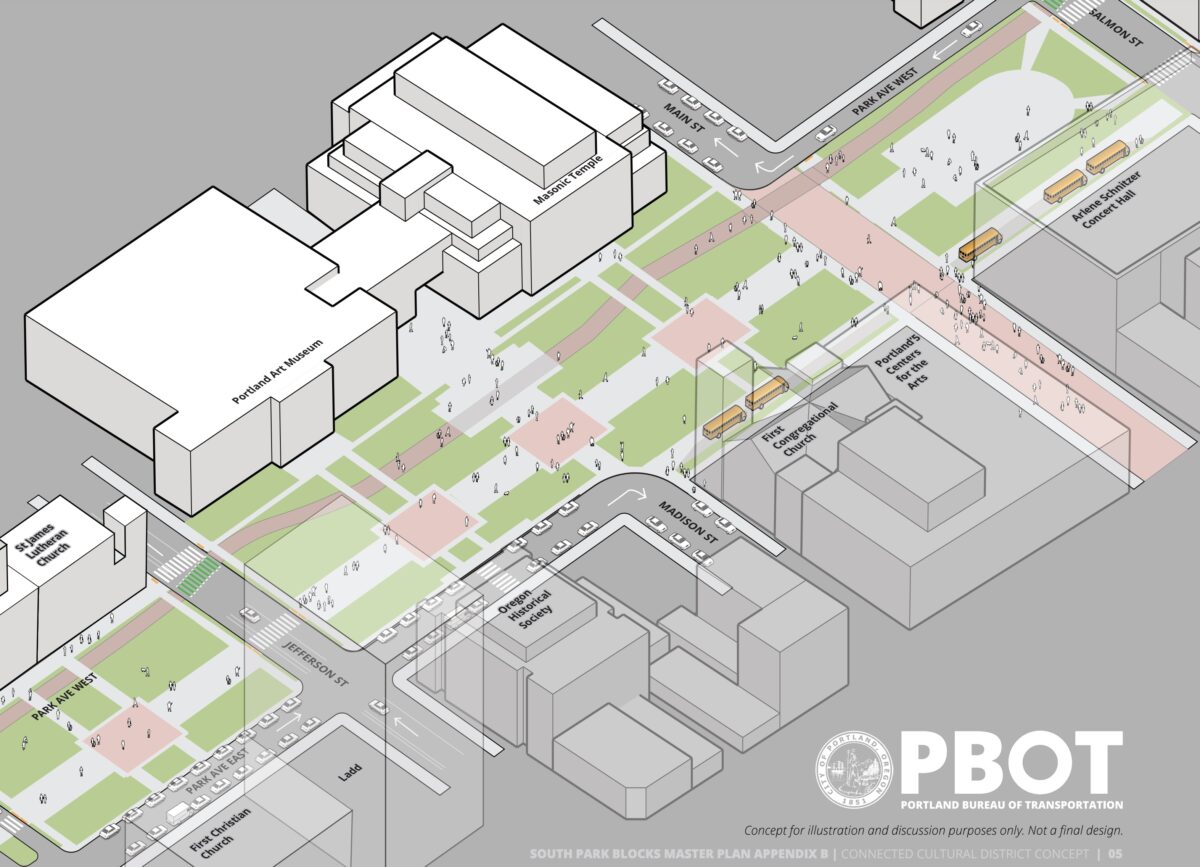
This is an opinion from BikePortland founder, editor, and publisher Jonathan Maus.
It’s unfortunate that the discussion about the future of the South Park Blocks has been poisoned by a misleading opposition campaign.
What we should be laser-focused on is something city planners call the Connected Cultural District Concept that would create the most exciting and significant carfree space in downtown Portland since a parking lot was turned into Pioneer Square in 1984. I mentioned this concept briefly in our story about the South Park Blocks Master Plan Update on Monday, but it deserves a much closer look.
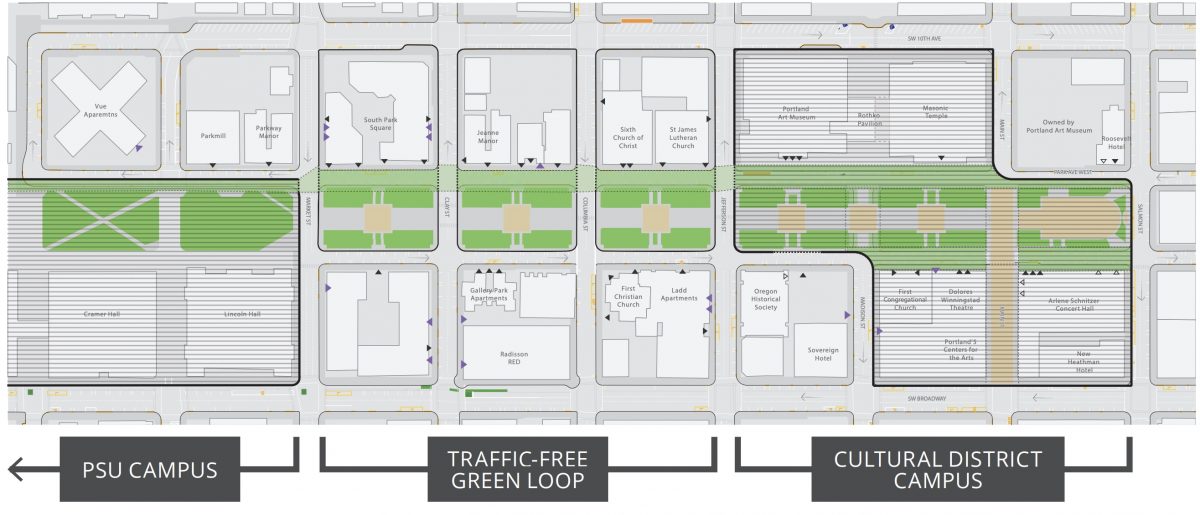
Led by the Portland Bureau of Transportation and Portland Parks and Recreation, the Connected Cultural District Concept emerged from their work on the master plan. In meetings during the public outreach process, city staff heard two key themes about the future of the South Park Blocks: “the desire to connect and expand the Park Blocks, and to minimize the impact of the streets surrounding them.” They responded by creating a 17-page appendix the master plan (Appendix B) that will be formally presented to City Council at 2:00 pm on July 7th.
A clear opportunity to push for an exciting carfree vision already sketched out (and all but endorsed) by two city bureaus, and with likely support from a majority of city council, is an extremely rare and valuable thing. This concept has real potential and we should take full advantage of our chance to get behind it.
In an email to BikePortland Wednesday, PBOT Senior Transportation Planner Nick Falbo referred to the concept as, “an emerging idea” and said even despite many unresolved questions about funding, operations, and access, “early conversations with stakeholders were supportive” . “It is included as an appendix to the master plan in part to offer the community something to rally around,” Falbo wrote. “Particularly for those who wanted to push the envelope a little more.”
Advertisement
“Those” could include a lot of Portlanders who understand that great cities are ones where people and places are prioritized over cars. There’s been strong support for carfree spaces in downtown for many years — from healthy city advocates and from many city council members — but we’ve always lacked a concrete vision to latch onto. This Connected Cultural District Concept is that vision.
What exactly does the concept entail?
In a nutshell, it’s a recommendation to extend the park across SW Madison and SW Main streets and expand the plaza in front of the Portland Art Museum — a move that would create a larger park space, uninterrupted by loud, toxic, dangerous cars. PBOT and Parks refer to it as a “traffic-free Green Loop that would link the Cultural District campus and Portland State University’s pedestrianized campus to the south… ” (Note how the city uses “traffic-free” because it’s less controversial than “carfree”. The plan would create lots of traffic — it would just be mostly human-powered.)
Here’s more from Appendix B:
“Inspired by the transformation of the South Park Blocks through Portland State University in the 1970s, the Connected Cultural District envisions a campus for children, visitors, events and community activations to take place. The traffic-free zone would span from building to building, creating an expansive new experience, and opening new opportunities for community use. The Green Loop could extend this area as a traffic-free street on Park Avenue West.”
Specifically, the concept is to pedestrianize two blocks of SW Main Street, SW Park Avenue East, and SW Park Avenue West adjacent to the Portland Art Museum and the theater district between Salmon and Jefferson. It would also prohibit driving further south on SW Park Avenue West three more blocks from Jefferson to Market (where the Portland State University campus begins).
Advertisement
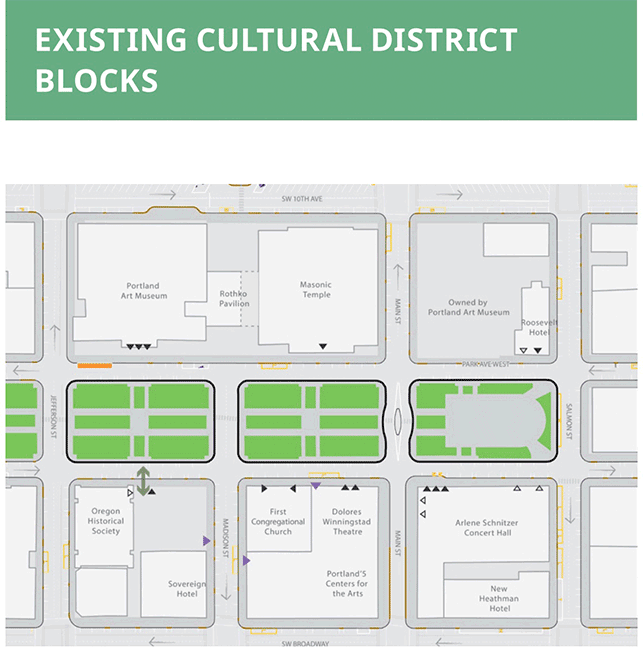
Given the rich cultural and community assets on these blocks, imagine the vast opportunities for new events and gathering spaces this could lead to. Portland Art Museum exhibits could spill into the park, performing arts groups could host plays, dances, concerts, and other events in a quiet, emissions-free, safe space in the heart of downtown.
I haven’t gotten an official comment from PBOT Commissioner Jo Ann Hardesty or Parks Commissioner Carmen Rubio about the concept yet, but it is very likely both are in full support of it. Hardesty has made her vision for more carfree spaces her highest transportation priority and it’s her bureau staff who’ve come up with the concept. Rubio’s office has told me she’s aware of the concept and is all-ears when it comes to hearing whether or not the community wants it to happen (I might have more on Rubio’s position Monday). There’s surely at least one more vote on the five-member city council (hi Commissioner Mapps!) to get this concept strongly endorsed and poised for its next steps at the hearing on July 7th.
To be clear, this is still just a concept. A very mature and well thought-out one, but a concept nonetheless. There’s no funding behind it and the hard conversations about access, maintenance, and operations haven’t even started. Even so, this feels like a major opportunity to rally behind a vision; a chance for Portland to stand up for something that will move our city forward and help us get our swagger back when we so desperately need it.
If you’re one of the folks who feels Portland needs to “push the envelope a little more,” when it comes to making downtown work better for people and not cars, please consider sending a quick note to city council members telling them how excited you are for the Connected Cultural District Concept.
mayorwheeler@portlandoregon.gov
mappsoffice@portlandoregon.gov
comm.rubio@portlandoregon.gov
joann@portlandoregon.gov
commissionerryanoffice@portlandoregon.gov
— Jonathan Maus: (503) 706-8804, @jonathan_maus on Twitter and jonathan@bikeportland.org
— Get our headlines delivered to your inbox.
— Support this independent community media outlet with a one-time contribution or monthly subscription.



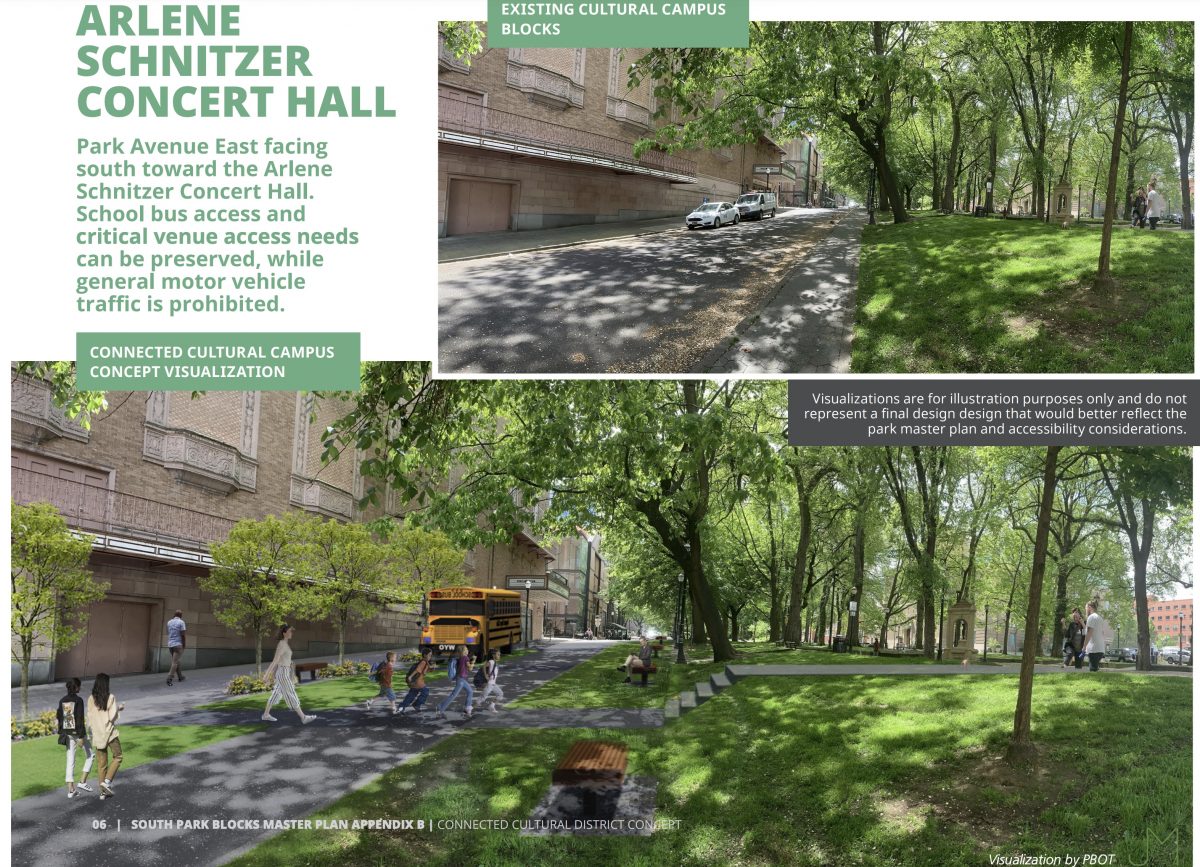
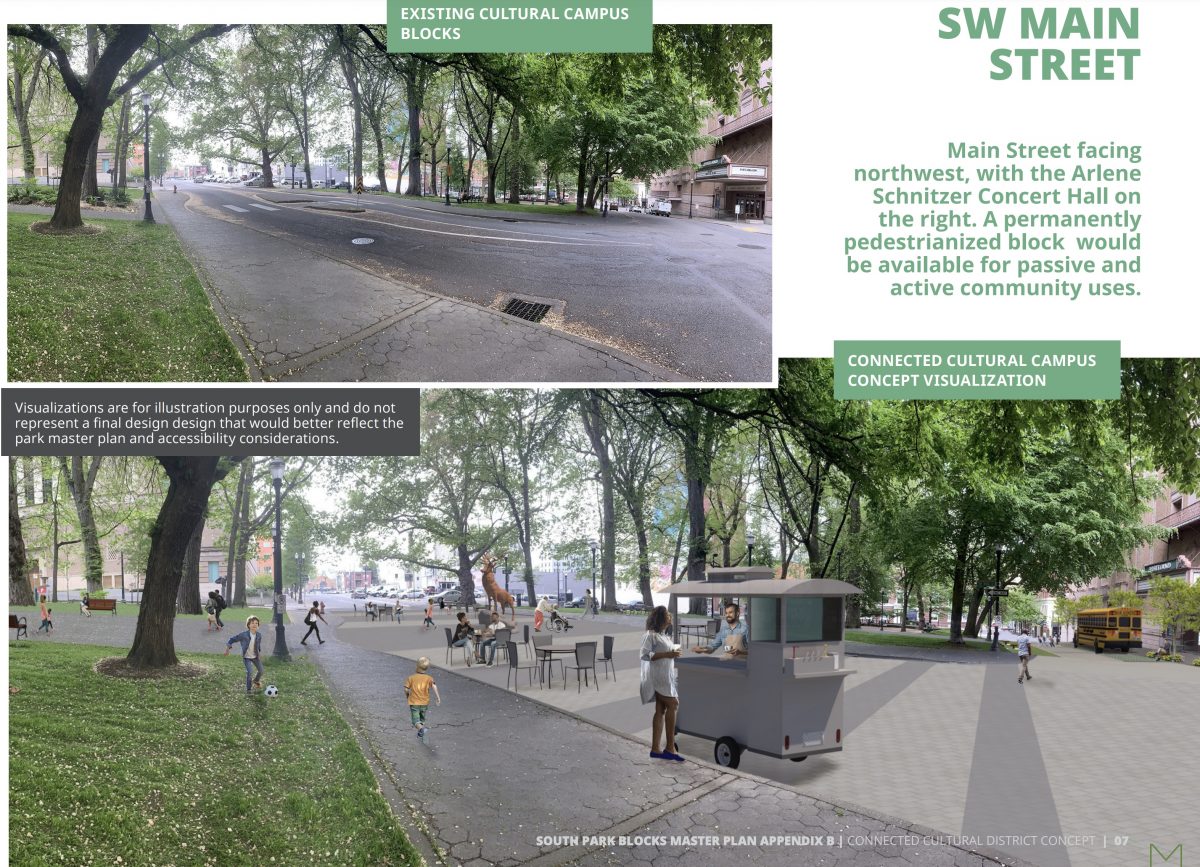

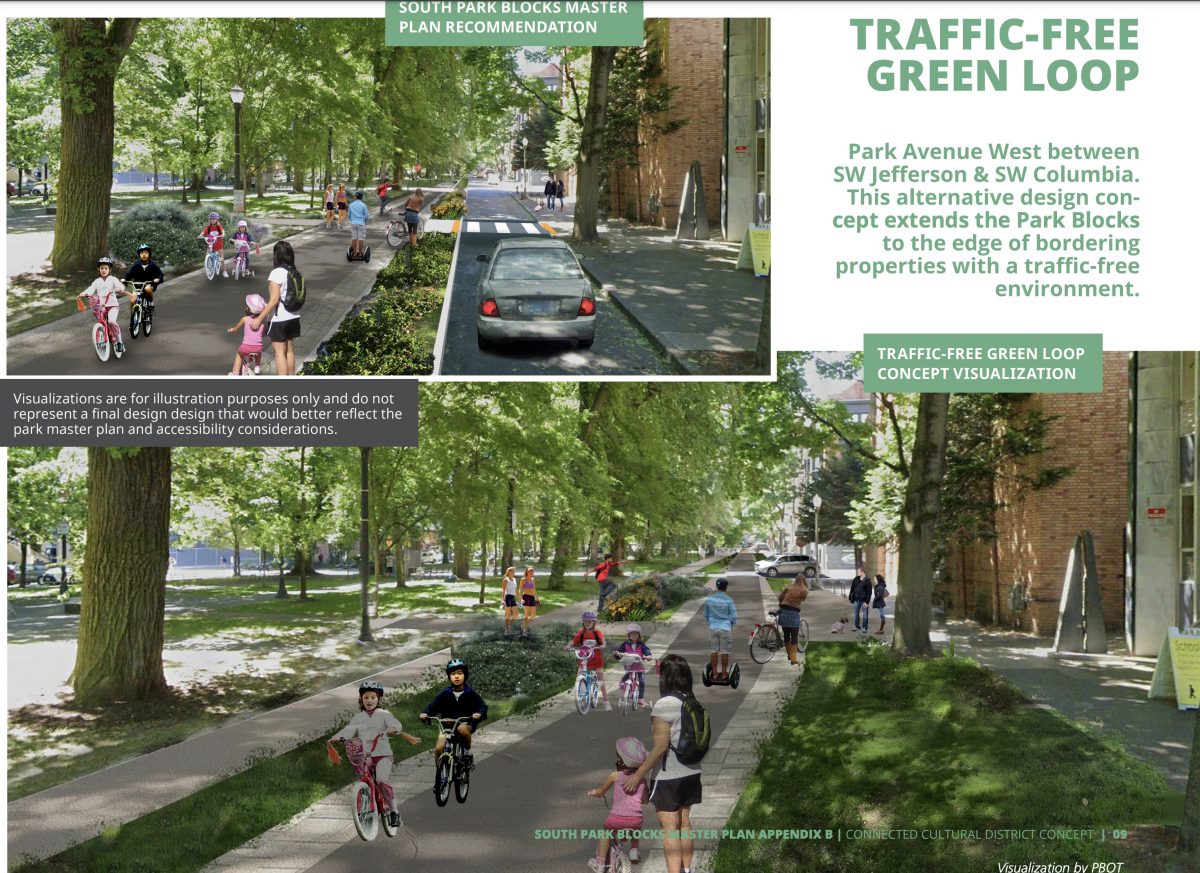
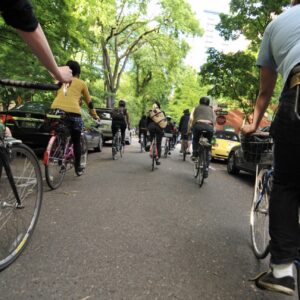
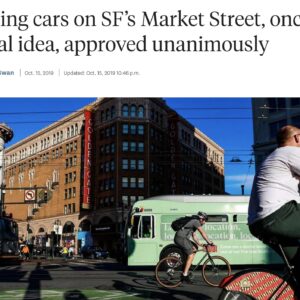


Thanks for reading.
BikePortland has served this community with independent community journalism since 2005. We rely on subscriptions from readers like you to survive. Your financial support is vital in keeping this valuable resource alive and well.
Please subscribe today to strengthen and expand our work.
Love, love, love! Such a bold plan and exactly the type of thinking we need.
The Connected Cultural District plan talks about connecting up to the traffic-free space at the PSU Park Blocks, but it actually goes even further than that. Most of SW Montgomery has been converted to a traffic-free pathway and serves as a E-W connection between PSU and the Halprin Sequence (recently dubbed the Fountain District) which has it’s own network of traffic-free streets.
In fact, I think something people don’t realize is that Portland already has a really robust series of traffic-free streets across the downtown nieghborhoods. With a little more work to connect them together, both physically and conceptually, this could honestly be a real destination for locals and visitors alike. It is a great way to build on Portland’s long history as a transportation pioneer, and create a new, one-of-a-kind attraction that strengthens the economic vibrancy and quality of life of our downtown community.
The Connected Cultural District is an awesome step toward making this dream come true: Portland, Oregon – Walking Capital of the US!
PS – I put together a map of Portland’s existing traffic-free streets (with the Park Blocks already included as aspirational), check it out here: https://45eb30fb-7e85-489a-8675-1e5d9b105a18.filesusr.com/ugd/a6a132_76b2585633894ef3bfb3b27b3e999cf4.pdf
Same Josh! Check this: my thoughts on emerging from the pandemic with rapid and cheap/free solutions. Many could be permanent. “Better Blocks” on steroids. Barrier similar streets to your plan, connect with existing paint on streets by removing car parking and using old tire barriers to protect car-free paths. https://twitter.com/MichaelOwensMD/status/1404917373283405826?s=20
Wowowow this would be incredible!!!!!!! I just sent an email to the commissioners.
Excuse my skepticism but Portland can’t take care of the parks it now manages. I love parks,trees,pedestrian spaces and quiet, car free spaces. We get great plans and capital improvements money but no maintenance funds so our nice spaces become not so nice, squalid, fenced off or abandoned and over run with campers.
Is there no reality check in the planning department?
Three reasons Portland Parks are in pickle:
1 – Lock of funding. Parks seems to be an afterthought in funding priorities.
2 – Too many (expensive) active uses. Ballfields, mowed grass, etc.
3 – An deference to certain parties that keep parks static and almost “walled gardens” that then prevent community care of parks, increasing long-term budgetary requirements.
#1 – By and large, Americans and especially American government (at all levels) do not value parks. So no parks system at any level of government is swimming in cash. But some cities do have set funding requirements to their parks, meaning no matter the surrounding budgetary climate the parks don’t get sudden reductions in funding. Portland Parks don’t do this and that means Parks takes it in the shorts every time there is a funding shortfall. (Which is a lot of the time.)
#2 – Take a gander at the parks themselves and you see a lot of mowed grass, ballfields and other active use structures. These things cost money in construction and upkeep. Once acre (approx. 208ft square) costs an average city $900 a year to maintain. Basketball, tennis courts, playgrounds – its expensive to put in and lifecycles are short, meaning as much or more are spent at the end of the lifecycle to “restore” them. Not saying it all has to go, but in many places this stuff exists in spades at local schools and community centers. So some of it is redundant. And then their are the golf courses… Golf courses are some of the most land intensive public uses as well as the most expensive. Even shutting down golf courses, ripping up the infrastructure and letting them go natural would help the Parks budget far more than you know.
#3 – When you (as the Parks) department bow down to certain neighborhood groups about a park, their desire to keep everything “as is” means you can’t bring in new ideas or fresh blood. Look at Forest Park. The master plan hasn’t been updated since 1995 because to do so would enrage as small, very rich, very homogenous group. Mountain biking on singletrack is a no go. Nature play areas are no go. But, both these types of uses come with a raft of fairly young, vigorous volunteers that can take up the slack for the Parks department. Other cities leverage access for money or work or both. By turning parks into private gardens for the neighbors, it leaves the Parks department with little slack. Marcy Houle ain’t ever going to swing McCleod or do trail work, but she will work to prevent other who would do that from doing so.
Cyclekrieg,
Your #1 is False. A $48 Million PER Year Parks Tax levy was just passed. They just spend it on political agenda items (such as granting access to certain preferred groups and then giving away 50% of PP&R swim lessons) instead of spending it on basics such as keeping parks clean and repaired.
Just to clarify, a levy pays for a budget, not the budget itself. In fact, even if you argue the levy pays for Parks, its only for five years, meaning in 2025, the same issue will reoccur. What I was referring to was other cities that have minimum budgeting requirements for the Parks department, that is, X amount of funds per a person per a year go to parks. Many of them have “forever levies”, too, that only need to reaffirmed every so many years, versus going before voters. And yes, spending money on stuff like PR campaigns, etc. is part of the issue.
The golf courses made a profit in fiscal year 2018 and 2019, so that’s completely false.
And in 2017, $900,000 had to be taken from the general parks budget to cover long term operating losses. Also, there are some courses that make money year over year and some that lose money consistently.
It seems there is egg on Jeff’s face. Golf is dying fast! Just ask the national organization.
Mt. Biking in Forest Park is not the topic of this thread. Trying to leverage that agenda by devaluation of baseball, tennis, soccer and golf dismisses park user groups who participate in fun, healthy and valid pass times enjoyed by many. FWIW the Forest Park is already “ nature play” and the idea of volunteers performing park maintenance is a lawyer’s wet dream.
Granpa,
It appears you are not aware that Portland Parks (and many other gov’t agencies) already have agreements with groups like NW Trail Alliance to perform volunteer maintenance. PP&R absolutely could and should engage NWTA to make FP a better place. The fact that they don’t/won’t speaks to how deep the anti-bike sentiment runs in PP&R/Parks Foundation, civic old guard in Portland.
Volunteers maintain hundreds of parks and thousands miles of trails in other cities. In fact, the Forest Park Conservancy does some of the trail maintenance now, though the volume of work is rather low.
Also, not devaluating other park users. Just suggesting that some (active) uses are both expensive and over-programed.
Actually, nature play is a specific thing, which Forest Park does not have. Nature play areas, if you are unfamiliar with them, are a section of the forest, typically with no set structure, that allows kids to do what kids do best: play. Some of them even have tools available to the kids to dig and make things – shovels and hoes usually. Forts, etc. Here is video of a Danish Kindergarten in a nature play area: https://youtu.be/Jkiij9dJfcw
@ Cyclekrieg
My comment is in response to your railing that active park pastimes that require maintenance take up a disproportionate percentage of park bandwidth. Your post sounded like you were questioning why volunteers were not allowed to run mowers and equipment. Hence my mentioning lawyers. That it seems, was straw man opening to your thread hijack to complaints about forest park use.
FWIW I am familiar with the contrived Nature Play seen in some Portland parks. Those are nice features but are pale in comparison to actual nature play in lush natural settings. You talk about squandered park funds, yet complain that a facsimile of nature is not installed in the Forest Park. Sigh
No attempt to hijack the thread regarding trail access. There is direct connection between having trail access and understanding the power volunteer groups can bring to the table. If neighborhood groups (like those around Forest Park or RVNA) are actively preventing that understanding from being created in Portland, they are costing the tax payers money.
Also, just we are clear, Portland Parks “natural playgrounds” are anything but and are not the type of infrastructure I was referring. True natural play areas are typically done, not as a constructed pile of logs or something, but by fencing off a section of the forest, maybe a couple acres, and allowing the kids to play within that space. The fencing (usually something like split rail fencing or a more natural type) is there to define the space, nothing else. Remember, kids are climb trees, dig holes, dam creeks and generally do kid things. You want to keep that localized. There are typically some benches, etc. for parents to set. On certain days, volunteers come in to tech kids about the forest, how to carve wood, or build things, etc. The goal isn’t to create structured place, but an unstructured place, one that changes with time & the seasons.
Thanks for this call to action.
Here’s how I closed my letter:
We can make this happen!
I guess “don’t do that” would be my immediate answer.
This will be part of the Green Loop, so maybe push for City policy to keep all segments of the Green Loop open 24/7/365 once it is finished. Even if there’s a fenced-in music event or something in the Cultural District (remember Artquake back in the day?), keep the road/walkway in front of the Art Museum open throughout the event — no exceptions.
This is fantastic! We need to envision a more “traffic-free” (car-free) future. Thanks so much for bringing it to attention, Jonathan. I have emailed all five city council members in support of the concept.
This looks truly spectacular! Provided that city leadership has learned its lesson about letting the abuse of our public spaces run rampant, this would be an absolute gem — the type that would inspire further investment in the arts and our most special places.
Let’s put our voices behind this plan! I’m emailing city council now.
Good point. The South Park Blocks from their creation were envisioned as quiet spaces, which is why they’re surrounded by non-commmercial zoning. There should be some sort of management plan (as some other parks have) to preclude uses like you mention.
Parks has made mistakes in the past allowing large, intrusive commercial uses that disrupt and damage parks. It can be especially bad when the park is also part of transportation routes, like you mentioned.
Actually, this is where the “it will kill the trees” is a valid argument. Maybe people opposing this plan could be allies in getting a strong management plan in place. Maybe some opposition to the project could be lessened if creating that type of plan was made a condition of approval for the project. You could also argue that since this plan makes the Parks Blocks more important for transportation (bikes and walking, it’s never been important for vehicles) that makes a good argument for limiting events that interfere with that, and I’d guess many opponents of the project are not fans of the big events.
We should shut the entire downtown down from cars. I mean, go big right!?!
Serious or sarcasm?
That was part of Hunter S Thompson’s platform when he ran for mayor of Aspen in the 70s, and he only lost by a small margin. Amazing how little progress we’ve made since then.
All well and good but not. The north end of this park still beats all traffic and the planners I doubt have been not forced as we have to watch the traffic patterns and rioters and junkies and skateboarders that developed the past year and a half.
Those kids should really stay off your lawn.
If it’s my lawn yes they should.
Looks great but unfortunately we don’t have the $ to fund it. Despite the millions of relief dollars pouring in from the feds it’s being spent on police overtime (due to the anarchist’s attacks on our once fair city) and the city and Multnomah county’s (directed by Deborah “let’s waste taxpayer money” Kafoury) homeless plans that won’t work but will be effective in wasting millions and millions of dollars without any improvement . We need to change course and invest in long lasting improvements for the city such as this. We need inexpensive homeless camps that are safe and clean and then enforce NO camping regulations. Thinking we are going to afford and build permanent housing for all the homeless in America in one city is wishful thinking. We need to return to pragmatic progressivism and make this city work for ALL its residents. Let’s direct money to projects that benefit all hard working Portlanders like a Park Blocks that is safe from cars!